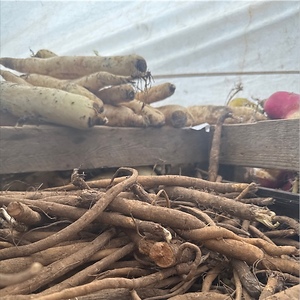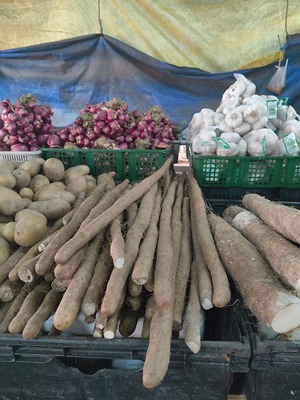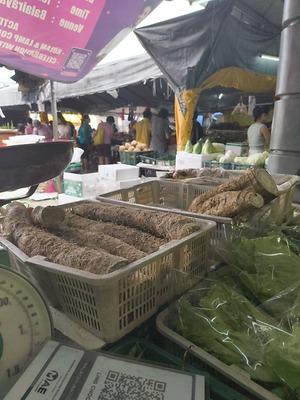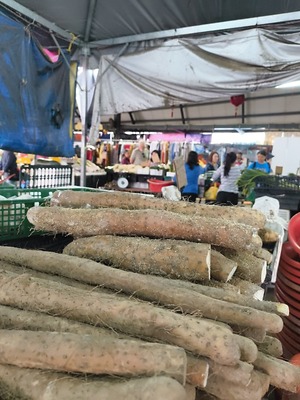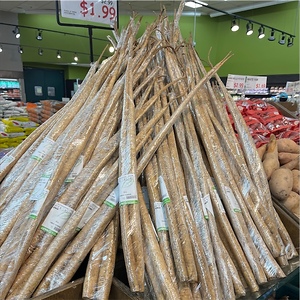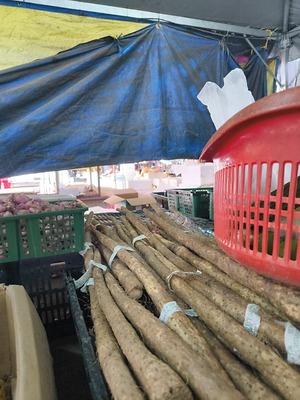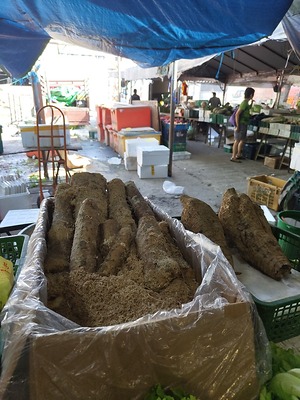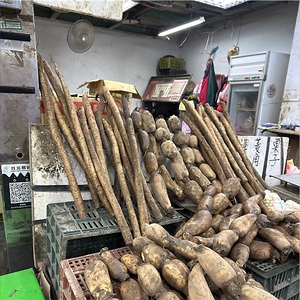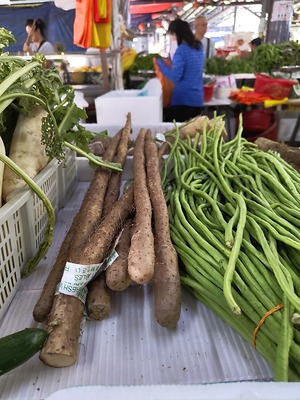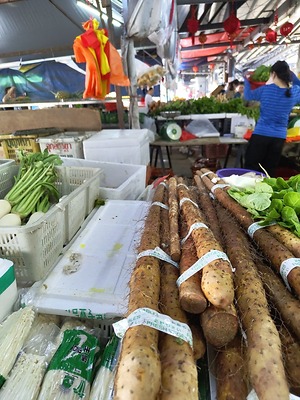


Burdock Root (Gobo)
Estimated Inventory, 10 lbs : 4.41
This item was last sold on : 06/30/25
Description/Taste
Burdock roots vary in size depending on the growing environment and maturity, but the roots can range from small to large, extending 30 to 100 centimeters in length. The roots have a characteristic straight, slender, and woody, carrot-like shape, about 2 to 4 centimeters in diameter, and taper to a slightly pointed tip. The semi-thick skin is rough, textured, and hard, showcasing beige, cream-colored, to light brown hues. The surface is also covered in dark brown markings, scratches, spots, and small root hairs. Underneath the skin, the white to ivory flesh is dense, fibrous, and starchy, with a chewy and crisp consistency. Fresh Burdock root should appear plump and should not be wrinkled or weathered, a sign of old age. The roots have a neutral, bitter, subtly sweet, acrid, earthy, and sometimes astringent taste. In addition to the roots, the plant's long-stemmed stalks with large leaves are edible and have an asparagus-like, vegetal flavor.
Seasons/Availability
Burdock root is available year-round, with a peak season in the summer through fall.
Current Facts
Burdock, botanically classified as Arctium lappa, is the primary root of a flowering, perennial plant belonging to the Asteraceae family. The long and slender roots can extend almost one meter in length into the Earth, acting as a strong, sturdy base for a large-leafed upright plant. The name Burdock is derived from the French word "bourre," meaning "entangled wool" or "burr," which is a sticky seed pod, and the German word "dock," meaning "large leaves." Historically, Burdock plants have been used in medicinal remedies worldwide for thousands of years, and the leaves, stalks, and roots are edible. Beyond medicinal uses, Burdock roots are consumed as a culinary ingredient in some cultures around the world, most notably in Japan. Burdock root is known as Gobo in Japan and is harvested by hand to keep the root's elongated and straight nature intact. The roots provide added texture and earthiness to dishes and are primarily utilized in cooked preparations as an enhancement.
Nutritional Value
Burdock root has been incorporated into natural medicines since ancient times. The roots are widely used in Traditional Chinese Medicine, believed to be a cooling, soothing element. Burdock roots cleanse the body as a natural diuretic and act as a blood purifier, ridding the body of excess toxins. The roots are also used in tinctures, supplements, powders, oils, and extracts to soothe sore throats, calm rashes and skin irritations, and stimulate digestion. Nutritionally, Burdock roots are a source of vitamin C to strengthen the immune system, fiber to regulate the digestive tract, and folic acid to generate new cells. The roots also provide potassium to balance fluid levels within the body, calcium to build strong bones and teeth, antioxidants to protect the cells against free radical damage, and other nutrients, including manganese, biotin, magnesium, copper, iron, and zinc.
Applications
Burdock root has a bitter, acrid, subtly sweet, and earthy flavor suited for cooked preparations to reduce its astringency. The roots are primarily utilized in Japanese and Korean cuisine and are fried, sauteed, boiled, or baked. Burdock is starchy and must be scrubbed and peeled before cooking. It can also be soaked in acidulated water to prevent oxidation and remove any astringent taste. The root is often used in stews, soups, stir-fries, or braised dishes. In Japan, Burdock root is famously used in Yanagawa nabe, a hot pot dish comprised of vegetables and meat, and kinpira, a type of slaw made with julienned Burdock root, carrot, dried chile peppers, and soy sauce. Kinipira was named after the well-known Japanese hero Kintaro, and Japanese locals believe eating this dish with a hint of spice will give them strength like the hero. Burdock roots are also served in miso soup with pork, pickled in rice vinegar, and eaten with sushi, or sliced thinly into coin-shaped pieces, fried, and served as a chip-like snack. During New Year's celebrations in Japan, Burdock root is simmered in a flavorful dashi with other vegetables and chicken in a traditional dish called chikuzenni. Outside of Japan, Burdock root is used as a flavoring agent in main dishes and can be cooked and added to meats, grain bowls, and soups. The root is also sliced into pieces and steeped in boiling water to make tea. In Europe, Burdock root was once used as a bittering agent in beer before hops. In addition to the root, the leaves and stalks of the plant can be cooked in vegetable dishes, stir-fries, side dishes, and candied, or they can be chopped and added to fresh green salads. Burdock root pairs well with meats such as beef, poultry, and pork, shishito peppers, sesame seeds, red chiles, shiitake mushrooms, radish, tomatoes, aromatics including garlic, onions, and chives, mirin, soy sauce, miso, and sake. Whole, unwashed Burdock root will keep up to two weeks when stored in the refrigerator.
Ethnic/Cultural Info
Burdock plants are often labeled as a witch's herb, as the leaves, roots, and stems were a common ingredient used in European potions and spells. The long primary roots create a persistent, strong plant symbolically seen as a plant unfazed by its surroundings. This bold, rooted nature led witches to include the plant as a magical ingredient in spells and charms to break hexes, provide protection, and ward off evil. Burdock root was often cut into small pieces and worn as a protective necklace, or pieces of the root were hung in doorways or buried by doorsteps as a barrier against evil. It was also mentioned among folkloric texts that wishes would be written on Burdock leaves and then burned to make them come true. Burdock's magical reputation permeated myths and legends throughout Europe for many centuries. In South Queensferry, England, Burdock is still used at the heart of an annual tradition for the Ferry Fair Festival each fall. The day before the festival, a man dawns flannel all over his body and is completely covered in the thistle-like burrs of Burdock, taking on the persona of the Burry Man. The burr-clad man is enveloped in the spiky pods, only revealing his eyes, and is paraded throughout the town with the help of two attendants to support the weight of his arms. Traditions of the Burry Man include schoolchildren following him in the streets shouting, "Hip hip hooray, it's the Burry Man day!" and the townspeople donate money, thought to bring good luck to their household. This annual tradition is also believed to draw evil out of the town, and in one day, it is normal for the Burry Man to walk over seven miles throughout Queensferry.
Geography/History
Burdock, also known as Great Burdock, is native to regions of Europe and Central Asia and has been growing wild since ancient times. The leafy, flowering plants with elongated roots thrive in temperate climates, typically in pastures, on disturbed ground, along roadsides, and in meadows, and are spread quickly by their prickly thistle-like burrs that stick to clothing and fur. Burdock was carried from Central Asia to East Asia in the early ages, and the plant was initially used as a medicinal herb in China. Over time, it was also introduced to Japan and Korea. In Japan, Burdock root transformed from a medicinal herb to a culinary plant by the Edo Period. Few countries outside Japan and Korea consume Burdock, but the plants have been recorded in various European texts as an occasional food source. Burdock is prevalent throughout Europe and was planted in North America by European settlers. After its arrival in the New World, Burdock naturalized and spread throughout North America, sometimes considered an aggressive, invasive weed. Today Burdock root is primarily utilized in natural medicines and is commercially cultivated worldwide for sale in supplements, tinctures, and dried form. In terms of culinary use, Burdock root is mainly incorporated into Japanese and Korean dishes. It is also used in soups and vegetable dishes on a much smaller scale in Europe. Burdock root grows in temperate climates worldwide and is sold through fresh markets, specialty distributors, and online retailers. The roots are also foraged from wild plants and are produced as a medicinal herb in home gardens in Asia, Southeast Asia, Australia, Europe, and North America.
Featured Restaurants
Restaurants currently purchasing this product as an ingredient for their menu.
| Fifty Two Remedies Bar | San Diego CA | 858-707-7016 |
Recipe Ideas
Recipes that include Burdock Root (Gobo). One



